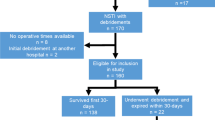Abstract
Objective: The aim of the underlying study was the evaluation of an aggressive surgical regimen for treatment of postoperative necrotizing soft-tissue infection (NSTI). Methods: Eight patients with postoperative NSTI of the abdominal wall after emergency (n=6) and elective (n=2) surgery were reviewed over a 9-year period. Results: Initially, three patients presented with general peritonitis. Cultured swabs from the necrotic tissue revealed three to four different types of bacteria in each patient. The mean interval between the primary operation and clinical symptoms of NSTI was 63.0 h. Control of NSTI and intra-abdominal infection was attained by scheduled re-operations on a daily basis accounting for three to six re-interventions in each patient. Temporary closure of the abdominal wall by absorbable polyglactid-acid mesh was used in six cases. Mean hospital stay was 65.3 days (18–110 days). Two of the eight patients died from cardiac arrest and multiple organ failure, respectively. Conclusions: Rapid diagnosis and onset of treatment is accomplished by the surgeons’ knowledge of this disease and a close follow-up of the patients in an intensive care unit.
Similar content being viewed by others
Author information
Authors and Affiliations
Additional information
Received: 29 March 1999; in revised form: 6 September 1999 Accepted: 7 September 1999
Rights and permissions
About this article
Cite this article
Bertram, P., Treutner, KH., Stumpf, M. et al. Postoperative necrotizing soft-tissue infections of the abdominal wall. Langenbeck's Arch Surg 385, 39–41 (2000). https://doi.org/10.1007/s004230050009
Issue Date:
DOI: https://doi.org/10.1007/s004230050009




